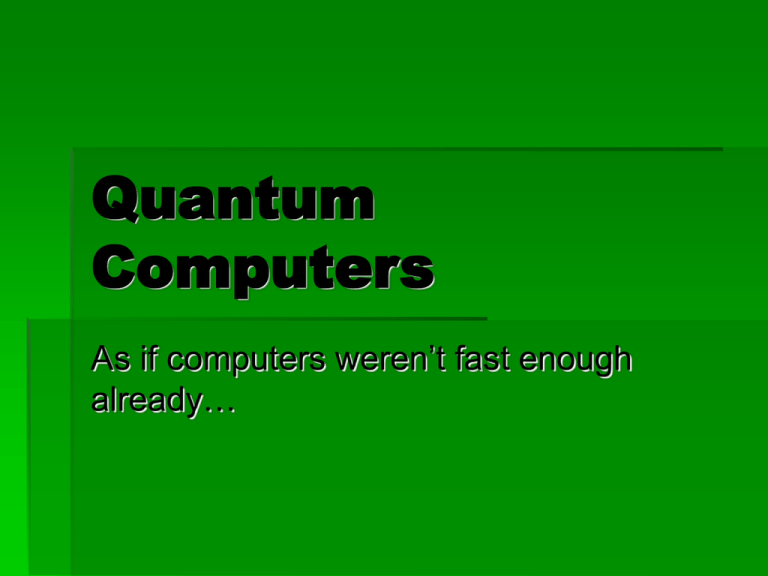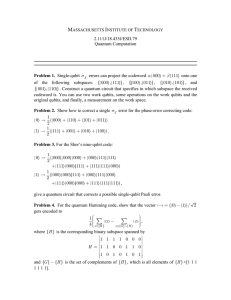BWestTalk2.ppt
advertisement

Quantum Computers As if computers weren’t fast enough already… Brief Outline Introduction – What is a quantum computer? Differences from classical computers Power(speed,efficiency, etc.) History Problems Conclusion What is a quantum computer? Computer using the laws of quantum mechanics Utilizes physical phenomena Quantum interference Superposition May seem to defy logic Mostly theoretical – many of the ideas cannot work due to quantum nature Photon Split? -> No! Classical Quantum Idea Idea The difference between classical and quantum computers Classical Bits – storage in 0’s and 1’s Uses Boolean logic gates to manipulate bits Macroscopic physical storage Charge, magnetization, etc. Governed by the same laws as everyday phenomena Can only manipulate one piece of data at a time Quantum Qubits – storage in 0’s, 1’s, or a superposition of both. Executes quantum gates to act as unitary transformations on qubits Uses quantum laws which differ greatly from everyday phenomena Can manipulate many pieces of data at once Computing speed and efficiency Qubit can hold as many values at once as a bit has range to hold 3 bits: can hold one number up to 8 3 qubits: can hold 8 numbers up to 8 Can perform many computations at the same time, as opposed to performing them one at a time Factoring, as an example Peter Shor, AT&T Bell Laboratories, New Jersey History Idea developed from the idea of elements being small enough to behave on the quantum level 1982 – Feynman comes up with idea for computations. Says quantum computers can be used for quantum simulations. 1985 – Duetsch realized Feynman’s assertion could lead to a general purpose computer and published a paper that showed how. 1994 – Shor circulates a preprint of a paper showing how quantum computers could solve many mathematical problems many times faster than classical computers (namely factorization). 1995 – Theory of quantum error correction 1998 – Researchers at Los Alamos National Laboratory and MIT led by Raymond Laflamme spread a qubit across three nuclear spins in each molecule of a liquid solution of alanine or trichloroethylene molecules – possible with NMR (nuclear magnetic resonance) Spread makes it harder to corrupt – can indirectly measure decoherence and compare spin states Present - http://www.cs.berkeley.edu/~vandam/homes.html Problems Decoherence – tendancy of quantum computer to decay as it interacts (entangles) with the outside environment Qubits cannot be directly measured – lose superposition and change to 0 or 1 when attempted May try to set up an algorithm to cycle through qubits after they are manipulated, narrowing down the possible answers, until the probability of the right answer showing up is close to 100% Phase coherence may be used for error correction Architecture is too complicated, large, or expensive World is too dependent on current computer systems Ideas are fundamentally more difficult than classical computers Conclusion Quantum computer research is making breakthroughs We may someday have quantum computers for generic use Quantum computers could provide faster or better methods of doing most anything (encryption, as an example) There are too many problems for such breakthroughs to occur in the near future For those of you who have taken Quantum A & B: Quantum physics IS practical for something in our everyday lives – your nights and weekends spent on homework were not spent in vain! References http://library.thinkquest.org/C008537/qua ntum/computers/computers.html http://www.cs.caltech.edu/~westside/qua ntum-intro.html








